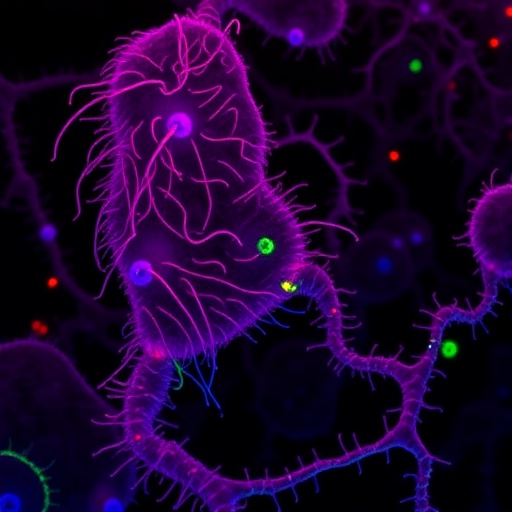In the intricate world of immunology, macrophages stand as pivotal sentinels of the innate immune system, capable of rapidly adapting their functional capacities in response to pathogenic threats. A recent breakthrough study has uncovered a meticulous reprogramming of nucleotide metabolism in classically activated macrophages, revealing how these immune cells tailor their biochemical pathways to meet the demands of an activated state. This in-depth exploration illuminates the nuanced metabolic shifts driven by nitric oxide, reshaping our understanding of immune cell functionality and metabolic regulation.
Macrophages undergo classical activation in response to specific pro-inflammatory stimuli, such as lipopolysaccharide (LPS) and interferon-gamma. This activation equips macrophages to combat pathogens more effectively, but it comes at a substantial metabolic cost. The recent study highlights that nucleotide metabolism, a fundamental cellular process typically involved in DNA and RNA synthesis as well as energy transfer, is rigorously remodeled during this activation process. Such metabolic rewiring supports not only the biosynthetic needs of activated macrophages but also their effector functions, including migration and phagocytosis.
Central to these findings is the observation that pyrimidine metabolism, particularly the de novo synthesis pathway, proceeds only up to the formation of uridine monophosphate (UMP). Beyond this point, the synthesis of cytidine triphosphate (CTP) and deoxythymidine monophosphate (dTMP) is effectively blocked. This selective blockade suggests a strategic metabolic checkpoint where nucleotide synthesis is throttled, preventing full pyrimidine biosynthesis and possibly favoring alternative metabolic fates or salvage pathways. The implications of this selective inhibition extend to DNA replication and RNA transcription dynamics within activated macrophages.
.adsslot_hHj8NaFUCy{ width:728px !important; height:90px !important; }
@media (max-width:1199px) { .adsslot_hHj8NaFUCy{ width:468px !important; height:60px !important; } }
@media (max-width:767px) { .adsslot_hHj8NaFUCy{ width:320px !important; height:50px !important; } }
ADVERTISEMENT
Parallel to pyrimidine modulation, purine metabolism undergoes even more dramatic reprogramming. The study reveals a shutdown of de novo purine synthesis at its terminal enzymatic step, catalyzed by AICAR transformylase/IMP cyclohydrolase (ATIC). As this critical enzymatic transformation is inhibited, macrophages pivot toward an increased reliance on purine salvage pathways, recovering purines from degradation products and ensuring a balanced nucleotide pool without the metabolic expense of complete de novo synthesis. This shift underscores a resource-efficient strategy aligned with the macrophage’s pro-inflammatory role.
Underpinning these multifaceted metabolic transformations is nitric oxide (NO), a well-known effector molecule in immune responses traditionally appreciated for its antimicrobial and signaling roles. The study positions NO as a master regulator orchestrating the broad repression and activation of enzymes within nucleotide metabolism. NO facilitates transcriptional downregulation of thymidylate synthase (Tyms), curbs ATIC enzymatic activity, and inhibits XOR function. Such simultaneous modulation across multiple metabolic nodes highlights NO’s centrality in coupling immune signaling to metabolic rewiring.
Delving deeper into the mechanisms, nitric oxide’s robust capacity to induce post-translational modifications such as S-nitrosylation likely contributes to the inhibition of key metabolic enzymes. This not only exemplifies how signaling metabolites can gatekeep metabolic flux but also suggests the presence of tightly regulated feedback loops that prevent overactivation or dysregulation during immune responses. By constraining nucleotide synthesis and promoting salvage pathways, NO ensures that macrophages maintain a precise balance between biosynthetic demands and metabolic economy.
The functional consequences of this remodeled nucleotide metabolism extend well beyond metabolic biochemistry. Experimentally, impairing purine salvage by knocking out hypoxanthine-guanine phosphoribosyltransferase (Hgprt) or pharmacologically inhibiting salvage enzymes results in dramatic phenotypic changes. These interventions alter the expression profile of genes typically induced during macrophage activation, implicating nucleotide metabolism as a critical upstream regulator of inflammatory gene expression networks. This intimate link between metabolism and gene regulation broadens our appreciation of immunometabolic cross-talk.
Further, the suppression of macrophage migration and phagocytic capacity upon blocking purine salvage underscores the practical importance of this metabolic pathway in innate immune functions. Macrophage motility and their ability to engulf pathogens are energetically and molecularly intensive processes, dependent on finely-tuned nucleotide pools. Disruption of these pools impairs these capabilities, highlighting nucleotide metabolism as a potential targetable axis to modulate immune responses in disease contexts such as chronic inflammation or infection.
The study also introduces a viral and parasitic pathogen angle by demonstrating that attenuated purine salvage capacity leads to enhanced proliferation of the intracellular parasite Toxoplasma gondii. This apicomplexan parasite exploits the macrophage intracellular niche, and its expansion is tightly regulated by host immune mechanisms. The finding that nucleotide metabolism remodeling in macrophages restricts parasite growth positions metabolic pathways as front-line defenders, finely balancing host defense and pathogen exploitation.
In sum, this research fundamentally reshapes our understanding of macrophage biology by unveiling how classical activation induces a functionally significant nucleotide metabolism remodeling, carefully choreographed by nitric oxide. It reveals a sophisticated metabolic architecture where selective enzymatic blocks and salvage pathway enhancements converge to support immune functions, minimize wastage, and constrain intracellular pathogens. Rather than being mere bystanders, metabolites and metabolic enzymes emerge as dynamic participants in innate immunity.
Looking forward, questions remain regarding the exact signaling cascades through which nitric oxide exerts its regulatory grip on these enzymes and whether similar metabolic rewiring occurs in other immune cell types or during alternative activation states. Additionally, the interplay between nucleotide metabolism and other metabolic pathways, such as glycolysis or fatty acid oxidation, presents an exciting frontier for systems immunometabolism exploration.
Furthermore, understanding how pathogens like Toxoplasma gondii might subvert or respond to host macrophage nucleotide metabolism could inform strategies to thwart intracellular infections. As a whole, this paradigm reveals the untapped complexity of immune cell metabolism, where classical biochemical routes are dynamically reconfigured to meet the challenges of host defense.
The integration of metabolic and immunological insights as demonstrated in this study exemplifies the cutting-edge of modern biology. It illuminates the metabolic underpinnings of immune activation with precision, shedding light on how macrophages fine-tune their internal molecular economy to execute complex physiological roles. Such discoveries underscore the promise of immunometabolism research in enhancing human health and combating infectious and inflammatory diseases.
In conclusion, the detailed mapping of nucleotide metabolic fluxes within classically activated macrophages reveals a landscape orchestrated by nitric oxide with profound functional outcomes. Through selective inhibition of key enzymes and bolstered salvage pathways, macrophages optimize their nucleotide pools to sustain essential immune activities while constraining intracellular pathogens. This work stands as a milestone in deciphering the molecular choreography of immune cell metabolism, opening wide the door to novel therapeutic approaches and deeper biological understanding.
Subject of Research: Classical activation-induced nucleotide metabolism remodeling in macrophages regulated by nitric oxide.
Article Title: Classically activated macrophages undergo functionally significant nucleotide metabolism remodelling driven by nitric oxide.
Article References:
John, S.V., Seim, G.L., Erazo-Flores, B.J. et al. Classically activated macrophages undergo functionally significant nucleotide metabolism remodelling driven by nitric oxide. Nat Metab (2025). https://doi.org/10.1038/s42255-025-01337-3
Image Credits: AI Generated
Tags: biochemical pathways in macrophage activationclassical activation of macrophageseffector functions of macrophagesimmune cell energy regulationmacrophage metabolism changesmetabolic cost of immune activationmetabolic reprogramming in immunitynitric oxide role in immune responsenucleotide metabolism in immune cellspathogen response mechanismspro-inflammatory stimuli effectspyrimidine metabolism in macrophages





